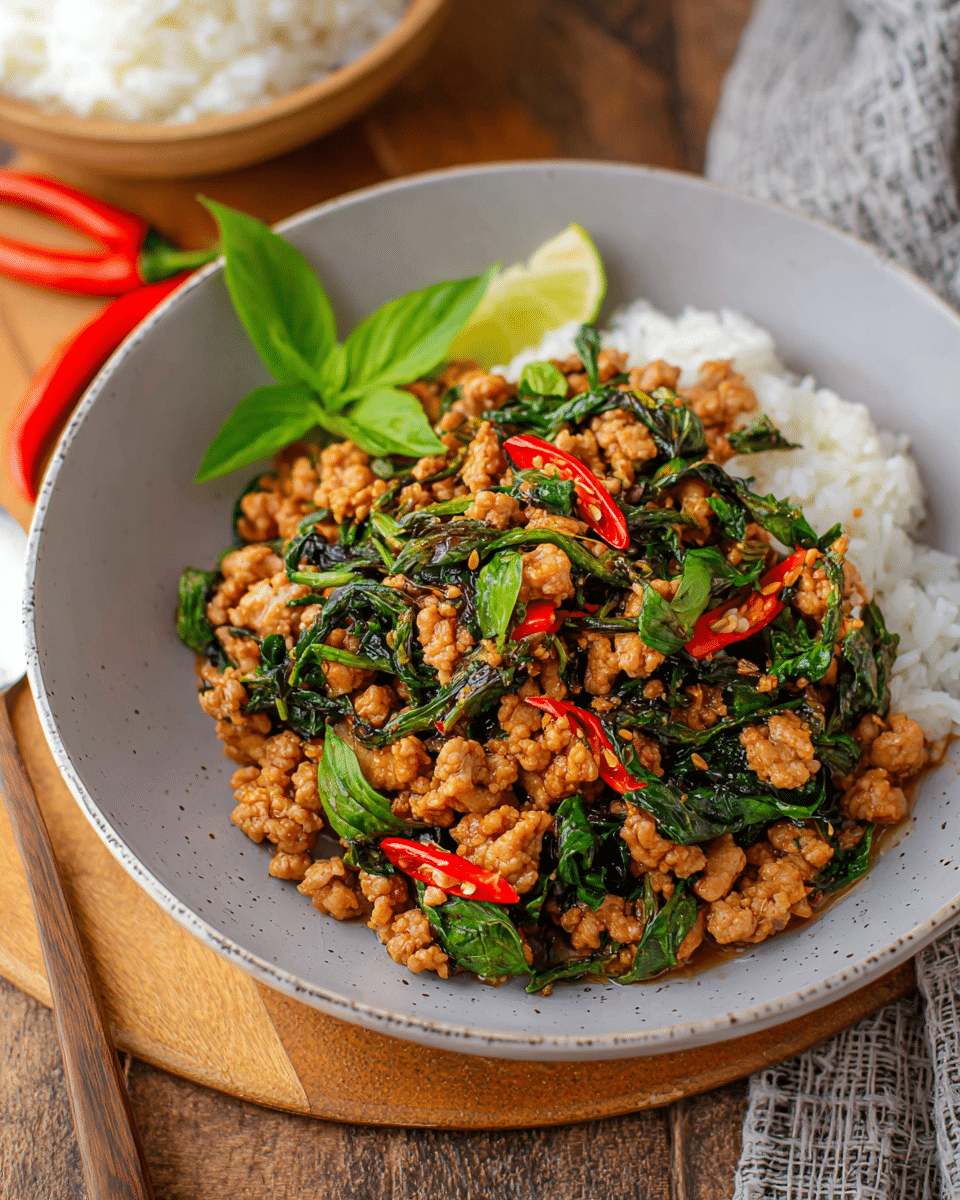Thai Basil Chicken is a classic Thai street food dish known for its bold, aromatic flavors and quick cooking style. The combination of fragrant Thai basil, spicy red chilies, and savory sauces creates an irresistible stir-fry that pairs beautifully with fluffy jasmine rice.
This dish is perfect for busy weeknights because it comes together in less than 30 minutes while delivering restaurant-quality taste. You can easily adjust the spice level, add vegetables like bell peppers or green beans, or swap chicken for ground pork or tofu to suit your preference. It’s a versatile, crowd-pleasing recipe that brings authentic Thai flavors straight to your kitchen.
Full Recipe:
Ingredients:
-
1 lb (450g) ground chicken
-
3 tablespoons vegetable oil
-
5 cloves garlic, minced
-
2 shallots, sliced
-
2–3 Thai red chilies, chopped (adjust to spice preference)
-
2 tablespoons soy sauce
-
1 tablespoon oyster sauce
-
1 tablespoon fish sauce
-
1 teaspoon sugar
-
1/4 cup chicken broth or water
-
1 cup fresh Thai basil leaves
-
Cooked jasmine rice for serving
-
Lime wedges for garnish
Directions:
-
Heat vegetable oil in a large skillet or wok over medium-high heat.
-
Add minced garlic and shallots, stir-fry for 30 seconds until fragrant.
-
Add ground chicken and cook, breaking it apart with a spatula, until no longer pink (about 5 minutes).
-
Stir in chopped Thai chilies, soy sauce, oyster sauce, fish sauce, and sugar. Mix well to combine.
-
Pour in chicken broth or water, and let the mixture simmer for 2–3 minutes, allowing flavors to meld.
-
Remove from heat, add fresh Thai basil leaves, and stir until wilted.
-
Serve immediately over steamed jasmine rice, garnished with lime wedges if desired.
Prep Time: 10 minutes | Cooking Time: 15 minutes | Total Time: 25 minutes
Kcal: 320 kcal | Servings: 4 servings
Thai Basil Chicken, also known as Pad Kra Pao Gai, is one of the most popular and beloved dishes from Thailand’s vibrant street food culture. This stir-fried chicken dish is infused with the aromatic essence of Thai basil and the heat of fresh chilies, creating a mouthwatering balance of spicy, savory, and slightly sweet flavors. Traditionally served over a bed of fluffy jasmine rice, this dish exemplifies the simplicity and boldness of Thai cooking. It’s quick to prepare, deeply satisfying, and versatile enough to adapt to various dietary preferences.
In this article, we’ll explore the origins, flavor profile, key ingredients, cooking techniques, variations, and tips for making the best Thai Basil Chicken at home. By the end, you’ll understand why this dish is a staple for weeknight dinners and a go-to option for anyone craving authentic Thai flavors.
The Origins of Thai Basil Chicken
Thai Basil Chicken originates from the streets of Thailand, where stir-fry dishes are a daily staple for locals. Known as Pad Kra Pao Gai (where “Pad” means stir-fry and “Kra Pao” refers to holy basil), this dish is cherished for its bold and vibrant taste. Traditionally, it’s cooked in blazing-hot woks by street vendors, producing a smoky aroma and intense flavor in just a few minutes.
The dish’s defining ingredient is Thai basil, particularly holy basil (not to be confused with the sweeter Italian basil), which has a slightly peppery, clove-like flavor. Combined with garlic, chilies, and umami-packed sauces like oyster sauce and fish sauce, Thai Basil Chicken showcases the balance of sweet, salty, spicy, and savory flavors that Thai cuisine is famous for.
What Makes Thai Basil Chicken Special?
The uniqueness of Thai Basil Chicken lies in its bold, fresh, and aromatic flavor profile. Unlike heavy or creamy dishes, this stir-fry relies on fresh herbs, minimal oil, and high-heat cooking to create a light yet intensely flavorful meal. The combination of garlic and chilies being stir-fried in hot oil releases an irresistible fragrance that sets the tone for the dish.
The quick cooking process helps retain the vibrant color of the basil leaves and the juiciness of the chicken. Served alongside jasmine rice, which soaks up the savory sauce, every bite delivers a harmonious blend of textures and flavors. For those who enjoy a touch of heat, the spiciness of Thai chilies adds the perfect kick without overwhelming the palate.
The Role of Thai Basil
Thai basil is the star of this dish. Unlike Italian basil, which is sweet and mild, Thai basil has a slightly spicier, licorice-like taste that elevates the overall flavor profile. In Thai cooking, basil is not just a garnish but a key ingredient that defines the dish.
There are different varieties of Thai basil, but holy basil (Ocimum tenuiflorum) is the traditional choice for Pad Kra Pao. If you can’t find holy basil, Thai sweet basil can be used as a substitute, though the flavor will be slightly different. The fresh aroma and flavor of the basil should always be added at the very end of cooking to preserve its freshness and bright color.
Flavor Balancing in Thai Cuisine
Thai cuisine is all about balance sweet, salty, spicy, and umami flavors coexist harmoniously in a single dish. Thai Basil Chicken achieves this balance through a combination of sauces and seasonings:
- Soy sauce adds saltiness and depth.
- Oyster sauce contributes umami richness.
- Fish sauce provides a signature savory, slightly briny flavor.
- A small amount of sugar balances the spice and saltiness.
The result is a dish that is not only bold but also nuanced, with each bite offering layers of flavor that keep you coming back for more.
Why Thai Basil Chicken is Perfect for Busy Weeknights
One of the main reasons Thai Basil Chicken is so popular, even outside of Thailand, is its simplicity and speed of preparation. It takes less than 30 minutes from start to finish, making it an excellent choice for busy weeknight dinners.
Since the cooking time is short, most of the work lies in preparing the ingredients chopping garlic, slicing chilies, and washing the basil leaves. Once everything is ready, the stir-frying process is quick and requires only one skillet or wok. The result is a hearty, flavorful meal that feels like restaurant-quality food but is made in the comfort of your own kitchen.
Variations and Customizations
One of the beauties of Thai Basil Chicken is how easily it can be adapted. Here are some variations you can try:
- Protein swaps: Instead of ground chicken, try ground pork, beef, turkey, or even shrimp for a seafood twist.
- Vegetarian option: Substitute chicken with firm tofu, tempeh, or a mix of mushrooms.
- Add vegetables: While the traditional dish is mostly protein-based, you can add bell peppers, green beans, or zucchini for extra color and nutrition.
- Adjusting spice: For a milder version, reduce the number of Thai chilies or replace them with red bell peppers for color without the heat.
By making these small adjustments, you can tailor the dish to your taste and dietary needs without losing its authentic Thai essence.
Tips for Making the Best Thai Basil Chicken
To achieve the authentic flavor and texture of Thai Basil Chicken, consider these tips:
- Use high heat. Stir-frying at high heat ensures that the chicken cooks quickly while developing a slightly smoky flavor.
- Prep all ingredients before cooking. The cooking process is fast, so have all ingredients chopped and measured in advance.
- Don’t overcook the basil. Add the basil at the very end of cooking, just before serving, to retain its fresh aroma and vibrant green color.
- Serve with jasmine rice. The light, fluffy texture of jasmine rice is the perfect complement to the savory, saucy stir-fry.
- Balance the seasoning. Taste and adjust the saltiness, sweetness, and spiciness as needed to achieve the perfect balance.
Nutritional Benefits of Thai Basil Chicken
Not only is Thai Basil Chicken flavorful, but it’s also relatively healthy compared to many takeout options. Using lean ground chicken helps keep the dish low in fat and high in protein. Thai basil is rich in antioxidants and has anti-inflammatory properties, while garlic and chilies are known for their immune-boosting benefits.
By controlling the amount of oil and sauces, you can make this dish lighter while still maintaining its bold flavor. Serving it with steamed vegetables or brown rice can make it even more nutritious.
Pairing Suggestions
While Thai Basil Chicken is often served with just jasmine rice, you can enhance your meal by pairing it with:
- A fried egg (Khai Dao): A sunny-side-up egg with a crispy edge is a classic addition to Pad Kra Pao in Thailand.
- Light soups: A simple Thai clear soup or miso soup balances the bold flavors of the stir-fry.
- Thai iced tea: The sweet, creamy beverage is the perfect counterbalance to the dish’s spiciness.
Why You’ll Love This Dish
Whether you’re new to Thai cuisine or already a fan of bold, spicy flavors, Thai Basil Chicken is a dish that’s hard not to love. It’s quick, affordable, and easy to make, yet tastes like something you’d find in a top-tier Thai restaurant. The combination of savory sauces, fresh herbs, and a touch of heat creates a meal that is both comforting and exciting.
Conclusion
Thai Basil Chicken is more than just a stir-fry it’s a representation of Thailand’s culinary philosophy, where fresh ingredients, quick cooking methods, and a perfect balance of flavors come together to create a dish that’s both simple and extraordinary. Its versatility allows it to suit any taste preference, and its quick preparation makes it a weeknight hero for busy households.
By mastering this dish, you’ll not only have a go-to recipe for satisfying dinners but also gain insight into the beauty of Thai cooking. Whether you enjoy it as a quick meal for yourself or serve it at a dinner gathering, Thai Basil Chicken will always impress with its vibrant flavor and authentic charm.






